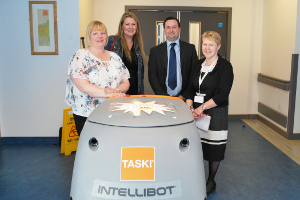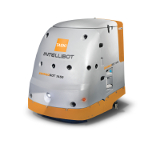Issue Date: 28 February 2018
Ref: DIV17/56
Robot Enhances Overnight Cleaning At NHS Fife
TASKI Intellibot offers numerous benefits to hospital cleaning team
In early 2017 NHS Fife’s Victoria Hospital became the first site in Scotland to deploy Diversey’s TASKI Intellibot robotic floor cleaning machine. The initial aim of improving the cleaning results and efficiency of the overnight cleaning team was quickly achieved. Now, having used the robot for nine months, the site is uniquely positioned to reflect on its impact on cleaning routines.
The ability to increase floor cleaning efficiency, standards and embrace new technology remain key benefits for NHS Fife. Where previously one member of the overnight team was tied up cleaning floors using a conventional scrubber drier, that person can now concentrate on other tasks or respond to cleaning requests in nearby areas while the robot (named Zig) gets on with cleaning the floors. Although the robot carries out the actual floor cleaning process, it is never left completely unsupervised with a member of the night team always working on other complementary tasks close by.
“A task that previously required two people is now done by one person and a robot,” says Midge Rotheram, NHS Fife Support Services Manager. “We promote this positively and using the robot allows the team flexibility and time to do the cleaning tasks that the machine cannot.”
Overall, the cleaning of the corridors and open spaces where the robot operates has improved. Results in busy and difficult-to-clean areas including entrances and main corridors and on anti-slip floors have been particularly noticeable.
“We get consistent floor cleaning every night, with the robot working in assigned areas of the site, it works steadily through its map for that area and the finished results are good and consistent,” says Midge Rotheram. “I believe these improvements are down to the pads that are now being used and the robot being heavier and slower than comparable conventional machines. This means greater pressure is applied to the floor for longer so that more soil is removed during each pass. Over time, floors become cleaner and there is less dirt to remove.”
The team has also noticed the robot’s sustainable cleaning capabilities. Innovative water and filtration systems mean that a single tank of solution lasts the full shift when cleaning the usual areas, which reduces water and product consumption and means that the cleaning team do not have to return constantly to the cleaning cupboard to empty and refill the tank. In most cases, one tank can last the full shift.
Under normal conditions the robot follows a predetermined path in designated areas using memorised internal maps. Diversey prepared these maps as part of its implementation process. Team members simply select the right map for the area and press a button to set the robot to work.
The robot can also operate in “area-clean” mode without any need for pre-configuration. It uses its on-board sensors and software to clean an area with minimal repetition. This is not as efficient as mapped mode but it does allow the robot to work occasionally in different parts of the hospital and increases its flexibility.
“We’ve started using the area-clean function to see if the robot will be more suitable than our conventional machines in other areas of the site,” says Midge Rotheram. “We like this flexibility because we don’t want to have to ask Diversey to come in and prepare a new map every time we want to try somewhere new or trial the robot in a new area. This allows us to wait until we have three or four new areas where we are confident the robot will work effectively and improve our results.”
Like all scrubber driers, the robot benefits from proper maintenance including routine weekly and daily checks. Diversey provided NHS Fife with detailed instructions and the overnight team has been diligent in following these. Simple tasks, such as cleaning the tank and checking filters, are completed after each shift, while other aspects of the robot such as seals and blades are inspected weekly. These checks are no more onerous than those required for conventional machines.
“Our robot still looks almost like new,” says Midge Rotheram. “It’s very good at displaying simple instructions and maintenance reminders when something needs to be done. We’re now looking to adopt similar step-by-step cleaning and maintenance processes for our other larger conventional scrubber driers.”
The robot has become integral to the overnight team’s routine. It has given staff a lift, taken some of the pressure off and allows them to concentrate on other cleaning tasks which improves the environment for patients, staff and visitors. The robot also remains a point of interest to other staff and patients within the hospital.
“The team continue to be keen and enthusiastic about the robot,” says Midge Rotheram. “We know that by using this technology we don’t need to worry about whether floors are being cleaned. It has become part of our team and we wouldn’t be without it now. Going back to the previous way of working would mean a complete rethink.”


